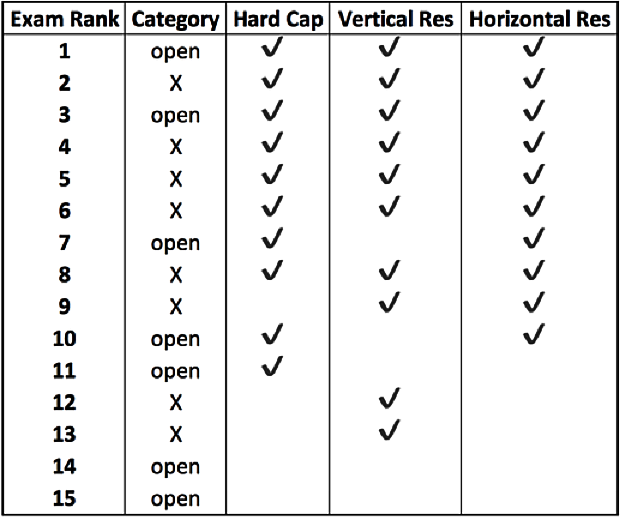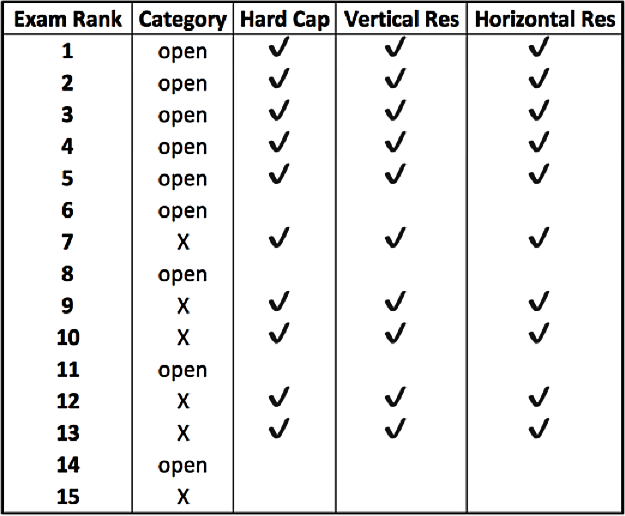In this expository piece, Ashutosh Thakur explains the various ways in which affirmative action policies can be implemented, and discusses the underlying tradeoffs and issues at hand. He delineates three implementation designs – hard cap, vertical, and horizontal reservation – in the context of poorly and well-performing candidates in hypothetical scenarios. However, in practice, the lack of detailed guidance has resulted in ad-hoc implementations of affirmative action policies that have long-lasting consequences for the political climate and legal discourse.
Allocation of scarce positions such as civil service jobs and IIT or IIM seats in India is often done on a meritocratic basis through competitive examinations such as CSE, JEE and CAT. Successful candidates must score high enough marks to clear the competitive exam cutoffs that equate the supply and demand of these highly sought-after positions.
For the most part, the only special consideration given in these merit-based allocation procedures are concessions based on affirmative action policies intended to promote the welfare of underprivileged groups. India has one of the largest, most explicit affirmative action policies: legal mandates prescribe that a certain fraction of seats must be allocated to Scheduled Tribes (7.5%), Scheduled Castes (15%), Other Backward Classes (27%), and Economically Weaker Sections (10%). In some cases, there can also exist affirmative action based on gender, disability, etc.
Historically, legislation has only specified the size of (that is, the percentage of seats reserved for) an affirmative action category, but the exact implementation protocols are often left ambiguous by the law. Hence ad-hoc implementations have led to several legal objections raised in the courts and courts have prescribed implementation guidelines in landmark judgments, like Indra Sawhney vs Union of India (1992).
As a result of the cut-throat competition and the sheer size of the affirmative action program in India, there has been much public debate over the politicized issue of who is entitled to receive affirmative action consideration and many court cases challenging the fine details of how these affirmative action policies are put in practice.
While I do not comment on the first issue, I believe that my exposition on the latter does carry the potential to alleviate some of those concerns. The following sections explain why implementation details of affirmative action matter and have long-lasting consequences on political climate, legal discourse, and public debate.
Normative criteria for affirmative action implementation
Once it has been agreed upon to provide affirmative action for individuals belonging to a particular group, (say ‘category-X’), there are two normative criteria an allocation procedure should satisfy:
i) Avoiding wasteful allocations where positions remain unfilled: The first notion of “non-wastefulness” necessitates there being sufficient supply of category-X individuals to meet the pre-specified demand. For example, if affirmative action for category-X is imposed for academic faculty at universities, each year there must be at least that many category-X individuals with PhD degrees in each of the university’s disciplines who want to pursue an academic career and apply for such positions.
If this minimum supply is not met, either the position is left unfilled (resulting in understaffed organisations with large class sizes, poor instruction quality, etc.), or the position is allowed to be de-reserved for non-category-X individuals (leading to the affirmative action goal not being met). This conundrum raises a fundamental policy question about whether affirmative action policies should be imposed in a one-to-one ratio corresponding to their proportion in the population at large (namely, if 20% of the population is category-X, should 20% of the seats be reserved for category-X), or less?
ii) Avoiding priority violations to ensure fairness in implementation: The second notion of “avoiding priority violations” is at the crux of most legal challenges and implementation issues in designing a merit-based system with affirmative action. Someone who did not get shortlisted will naturally be envious of those select few who did. However, this envy is justified only if someone with a lower priority (that is, a worse exam rank) than them, who also belongs to their affirmative action type, got the position instead.
When it comes to say shortlisting 10 people to fill 10 positions from an overall roster of 100 potential candidates who took the exam, in the absence of any affirmative action, a merit-based allocation procedure simply shortlists the 10 highest exam scoring individuals. Although individuals ranked 11th through 100th will be envious of the top 10 scorers, their envy is not justified given that the system is merit-based, and individuals ranked 1st to 10th have a higher priority for the positions than those ranked below them. Of course, if the assignment procedure shortlisted the 11th highest scorer without shortlisting the 10th ranked, the 10th ranked individual would have justified envy of the 11th’s position based on inter se merit, or the order of merit, priority violation.
Oftentimes, ad-hoc implementations that naively de-reserve positions or prioritise overlapping affirmative action categories without careful consideration run into such discrepancies leading to legal challenges. For example, if a shortlisted individual is a scheduled caste woman, does she count towards the affirmative action quota for gender or scheduled caste, and does this affect the possibility for justified envy for candidates in either category? Although I do not cover the case of overlapping affirmative action policies in this article, interested readers should refer to recent work by Sonmez and Yenmez (2022a, 2022b) on these issues.
Design options for affirmative action implementation
Now suppose that this merit-based procedure must also incorporate an affirmative action policy which mandates ‘50% of the seats be reserved for category-X individuals.’ There are three ways to interpret and implement this law:
- A hard cap that prevents more than 50% of the seats to be allocated to category-X individuals.
- A vertical reservation that does not count category-X individuals who qualified from the open category exam cutoff towards the 50% reserved pool.
- A horizontal reservation that counts category-X individuals who qualified from the open category exam cutoff towards the 50% reserved pool (that is, any category-X individuals in excess of 50% are qualifying solely based on merit).
Table 1. Various possibilities for implementation of 50% category-X reservation

Note: Operating on the assumption that there are 15 people competing to fill 10 seats (of which 5 are reserved for category-X), we use the three aforementioned design options to see how seats would be allocated among open and category-X based on this hypothetical ranking of candidates
Amongst the three implementations, the horizontal reservation seems the most appropriate as it guarantees minimum representation for category-X; does not reverse discriminate against category-X individuals; prioritises merit after the reservation is satisfied; exhibits a greater degree of fairness for non-category-X individuals; and is politically convenient in the long run, as once category-X individuals start performing well, the horizontal reservation becomes redundant. Let me explain these points with more detailed arguments and examples.
Most would intuitively object to a hard cap on the grounds that an affirmative action policy embedded in a merit-based allocation system should not be discriminating against someone for being category-X. As illustrated in Table 1, the category-X individual ranked 9th is not shortlisted because individuals ranked 2nd, 4th, 5th, 6th, and 8th already constitute the 50% hard cap and instead admitting open category individuals ranked 10th and 11th is unfair towards the category-X individual ranked 9th. Affirmative action is meant to help individuals from underprivileged backgrounds who might not otherwise get in, and not to punish those from underprivileged backgrounds for performing well.
This reasoning is probably what guided the Supreme Court to advocate for vertical reservation in Indra Sawhney vs. Union of India (1992): affirmative action is a minimum guarantee that ensures that at least 50% of positions be allotted to category-X on an over-and-above basis. Vertical reservation ensures that if category-X individuals qualify on the basis of merit alone, without taking any relaxed cutoff benefits for being category-X, they would not be counted amongst the 50% positions reserved for category-X. As seen in Table 1, ‘meritorious reserved’ individuals ranked 2nd, 4th, and 5th don’t count towards the 50% pool as they qualify based on the open category cutoff of rank 5. Then, the vertical reservation ensures that 5 additional category-X individuals are recruited from further down the merit list.
The tradeoff with vertical reservation ensuring that 50% category-X is a minimum guarantee, is that this comes at the expense of merit overall. In Table 1, open category individuals ranked 7th, 10th, and 11th are not shortlisted, while individuals ranked below them are shortlisted (in spite of the 50% category-X minimum already being fulfilled).
What is potentially missed in public and legal discourse is that vertical reservation is not the only way to establish a minimum guarantee of at least 50% category-X. Horizontal reservation prioritises both category-X and open category based on merit, while ensuring that at least 50% of category-X individuals are selected. As seen in Table 1, individuals ranked 2nd, 4th, 5th, 6th and 8th are the five top scoring category-X individuals let in by merit. Moreover, individuals ranked 1st, 3rd, 7th, 9th, and 10th are let in on the basis of merit regardless of whether they are category-X or not.
Herein lies the difference between horizontal and vertical reservations. Both ensure that at least 50% of category-X individuals are let in. However, when shortlisting individuals over-and-above the 50% category, horizontal reservations only consider merit (that is, the individual ranked 9th got in, not because of being category-X, but based on scoring high enough to make the cut). In contrast, vertical reservations don’t count the ‘meritorious reserved individuals’ who score high enough to qualify without affirmative action towards the 50%, and instead go even further down the exam rank to get an additional 50% category-X pool based solely on benefiting from the affirmative action reservation.
Are the exam rank cutoffs reasonable
In comparing these three implementations, we must consider what the appropriate exam rank cutoffs are for category-X and open category individuals to be shortlisted.
In Table 1, a hard cap unfairly implies a category-X cutoff of rank 8, above the open category cutoff of rank 11. This constitutes the basis for our intuitive objection that this system allows the possibility of reverse discrimination against category-X individuals performing well.
On the other hand, the cutoffs for vertical reservation are a category-X cutoff of rank 13 and open category cutoff of rank 3. These cutoffs may be considered reasonable given that it is less demanding for category-X individuals to get shortlisted compared to open category individuals.
Lastly, the appropriate cutoffs for horizontal reservation are rank 10 for both category-X and open category. It would be misleading to state that the cutoff for category-X is rank 9 while open category is rank 10. This is because individuals ranked 9th and 10th would have been shortlisted regardless of their affirmative action status. The appropriate cutoff is thus the worst rank that would have qualified, not the worst rank that happened to qualify from that particular category!
Long-run political consequences of vertical and horizontal reservation
Table 2 highlights that hard cap, vertical reservation, and horizontal reservation shortlist the same set of individuals when enough category-X individuals are not performing well enough to meet the 50% threshold based on merit alone. This is usually why affirmative action policies are instituted in the first place; it has been agreed upon that the sacrifice of merit by omitting the individuals ranked 6th, 8th, and 11th for the sake of diversity and representation of category-X individuals ranked 7th, 9th, 10th, 12th, and 13th is desirable.
Table 2. The implementation of 50% category-X reservation when category-X individuals do not perform well enough as a group
On the other hand, Table 1 and the resulting difference between vertical and horizontal reservation implementations underscores the long-run politics of affirmative action policies. Over time, as a consequence of successful integration, it is expected that once-underprivileged groups improve their performance and become increasingly competitive with their open category counterparts. Table 1 illustrates such a world in which category-X individuals perform well on their own merit. Although the affirmative action was set for 50% for category-X individuals, 6 out of the top-10 exam scorers belong to category-X.
However, vertical reservation continues to prioritize 50% category-X individuals in addition to the 3 who are amongst the top-5 exam scorers, thereby 8 out of 10 shortlisted individuals belong to category-X.
On the other hand, under horizontal reservation, as a result of category-X performing superbly on the exam, the affirmative action policy for category-X is rendered redundant! The individual ranked 9th has been shortlisted not because of any affirmative action, but because of merit alone. Now, 6 out of 10 shortlisted individuals belong to category-X.
Considering the underlying politics in this situation, with vertical reservation, open category individuals may start to grumble when category-X individuals start performing well (as in Table 1), that the vertical implementation harshly limits the scope for high-merit open category individuals. To address this concern, the legislature would have to actively pass new legislation overturning the old category-X affirmative action policy. However, politicians with re-election on their mind would perpetually fear losing this 50% vote bloc in doing so.
In stark contrast, horizontal reservation would simply become redundant once category-X individuals start performing well. Although the 50% minimum guarantee is still ensured, all those in excess of 50% would enter solely based on merit. No further legislation would be needed to overturn previous laws. Moreover, open category individuals couldn’t complain that there are not enough seats left over for them, because unlike with vertical reservation, in the horizontal reservation system this would be a consequence of their own bad showing.
Concluding remarks
This discussion highlights the fact that implementing affirmative action policies is not merely a decision of establishing the percentage of seats to be reserved – crucially, the fine details of the implementation protocols also matter. Those details have been underappreciated by the legislature and the judiciary alike. In practice, the lack of detailed guidance resulting in ad-hoc implementations of affirmative action policies has led to much political and social strife.
As a result of often choosing to implement the over-and-above criterion through vertical reservations instead of horizontal reservations, we continue to witness the effective number of unreserved seats based solely on merit shrinking as the affirmative action group’s performance improves. At such junctures, it remains politically inconvenient to legislate any reversal of affirmative action, and several groups may start advocating for expanding affirmative action to include themselves.
This post is the first in a three-part series on 'The architecture of affirmative action'.
Further Reading
- Sönmez, Tayfun and M. Bumin Yenmez (2022a), "Affirmative action in India via vertical, horizontal, and overlapping reservations", Econometrica,90(3): 1143-1176.
- Sönmez, Tayfun and M. Bumin Yenmez (2022b), "Constitutional Implementation of Affirmative Action Policies in India", arXiv: 01483.




 12 December, 2022
12 December, 2022 





Comments will be held for moderation. Your contact information will not be made public.